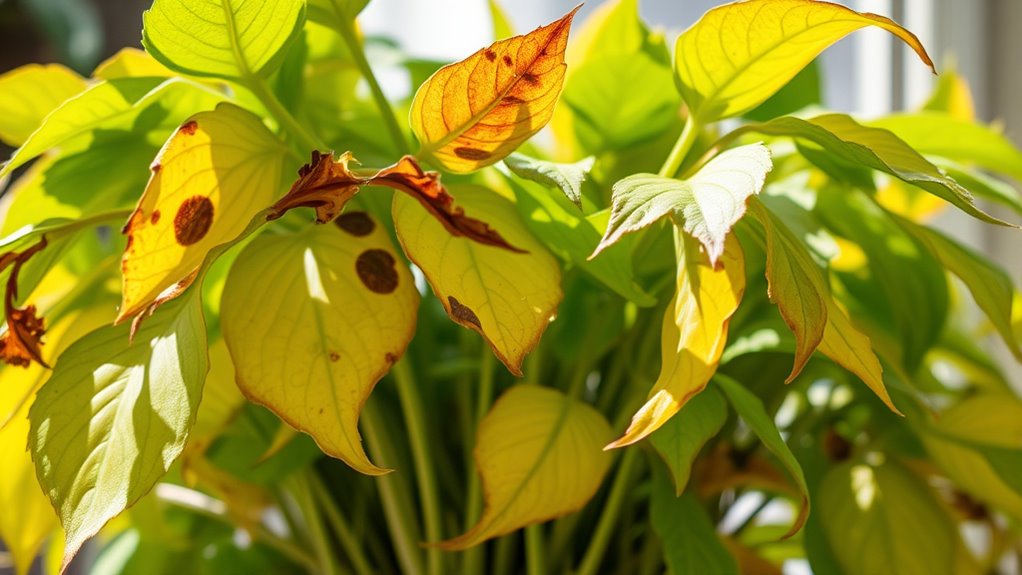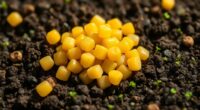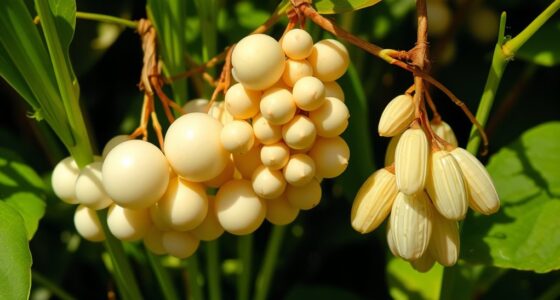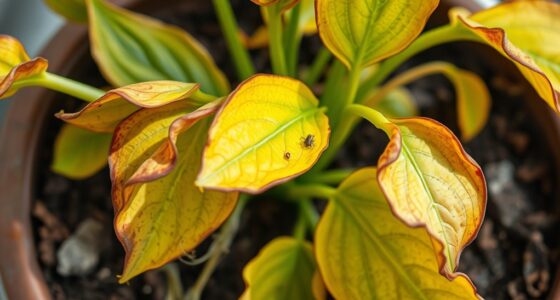If your plant shows yellow or wilted leaves, it could be watering issues or pests. Check if the soil feels soggy or bone dry; overwatering causes root rot, while underwatering leads to dryness. Look for pests like aphids or webbing on foliage. Spotting discoloration, spots, or deformation also indicates problems. Addressing these early saves your plant. For more tips to diagnose common issues and keep your plant healthy, keep exploring these signs.
Key Takeaways
- Observe leaf color and texture; yellow, brown, or crispy leaves indicate watering issues or nutrient deficiencies.
- Check soil moisture; soggy soil suggests overwatering, dry soil signals underwatering.
- Look for pests like aphids, spider mites, or webbing on leaves and stems.
- Inspect for spots, patches, or discoloration that may indicate fungal infections or low light.
- Assess overall plant vigor; wilting despite proper watering may point to root damage or disease.

Plants often show subtle signs when something’s wrong, making it essential to recognize these clues early. When your plant’s leaves turn yellow or wilt unexpectedly, it might be a sign of watering issues. Overwatering can cause roots to suffocate and rot, leading to drooping leaves and a general lack of vitality. Conversely, underwatering leaves your plant dry, crispy, and stunted. The key is to feel the soil: if it’s soggy and stays wet long after watering, you’re likely overdoing it; if it’s bone dry, your plant needs more water. Adjust your watering schedule accordingly, ensuring you’re not drowning or starving your plant of moisture.
Recognize early signs of watering issues by feeling soil moisture; avoid overwatering and underwatering for healthy plants.
Another common problem stems from pests, which can be less obvious but equally damaging. Pest identification is crucial because insects like aphids, spider mites, or mealybugs can weaken your plant, stunt growth, or cause leaf damage. Look closely at your plant’s foliage—are there tiny spots, webbing, or sticky residue? These are often signs pests are present. For example, small green or black insects crawling on leaves indicate aphids, while fine webbing may suggest spider mites. If you notice discolored or deformed leaves, pests could be the culprit feeding on your plant’s sap. Early detection helps you act swiftly—use a gentle spray of water to dislodge pests or apply an appropriate insecticidal soap. Regularly inspecting your plant’s undersides of leaves and stems can prevent infestations from going unnoticed.
In addition to watering issues and pests, other signs can point to underlying problems. Leaves turning yellow or brown may indicate poor drainage, over-fertilization, or insufficient light. Wilting despite proper watering could suggest root damage or disease. Spotting spots or patches on leaves might be fungal infections, which require prompt treatment. Recognizing these signs early allows you to take targeted action, whether it’s adjusting your watering habits, removing pests, or improving environmental conditions. Being aware of plant health indicators helps you address issues before they become severe.
Ultimately, paying close attention to your plant’s appearance and behavior is the best way to diagnose problems early. Regularly check for pest signs and soil moisture levels, and don’t ignore subtle changes in leaf color or texture. Address issues promptly, and you’ll give your plant the best chance to recover and thrive. Understanding these clues helps you become a more attentive gardener, ensuring your green friends stay healthy and vibrant for years to come.
Frequently Asked Questions
How Often Should I Water My Plant to Prevent Overwatering?
To prevent overwatering, you should establish a regular watering schedule based on your plant’s needs. Check the moisture levels by touching the soil; water only when the top inch feels dry. Factors like plant type, pot size, and environment influence how often you should water. Avoid watering on a fixed schedule without checking, as this can lead to overwatering. Adjust your routine to keep moisture levels ideal for healthy growth.
What Are Natural Remedies for Pest Infestations?
You can tackle pest infestations with natural remedies like homemade sprays made from neem oil, garlic, or chili peppers. Companion planting also helps by attracting beneficial insects or repelling pests naturally. These methods are eco-friendly and safe for your plants, reducing the need for chemical pesticides. Regularly applying homemade sprays and planting companions can keep pests at bay, promoting healthier, more resilient plants without harmful chemicals.
How Can I Improve Soil Drainage for My Plant?
To improve soil drainage, start by enhancing soil aeration through adding organic matter like compost or peat moss. Mix coarse sand or perlite into the soil to facilitate better drainage and prevent waterlogging. You can also create raised beds or amend the planting area with well-draining soil. These drainage improvements help roots breathe better, reduce root rot, and promote healthier plant growth. Regularly check moisture levels to maintain suitable soil conditions.
When Is the Best Time to Repot a Stressed Plant?
Think of your plant as a patient needing care; knowing when to act is key. You should repot a stressed plant when it shows clear stress signals, like yellowing leaves or slowed growth. The best repotting timing is during its active growing season, usually spring or early summer. This minimizes shock and helps your plant recover faster, turning it back into a thriving green companion.
Are There Specific Fertilizers for Different Plant Types?
You should choose fertilizer types based on your plant’s specific needs for ideal plant nutrition. Different plants require different fertilizer formulations—some thrive with high nitrogen, others with more phosphorus or potassium. Always read labels to guarantee you’re providing the right nutrients. By selecting the appropriate fertilizer types, you enhance growth and health, giving your plants the essential nutrients they need to flourish.
Conclusion
So, next time your plant throws a hissy fit, remember—its dramatic display of yellow leaves or wilting might just be begging for attention. Turns out, plants are pretty vocal if you know how to listen. Ironically, the signs you’re ignoring could be the very clues you need to keep your green buddy thriving. So, don’t let your plant’s silent protests turn into a tragic drama—pay attention, and you’ll both stay happy and healthy!









